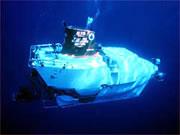 Alvin helped to discover deep-sea vent communities.© WHOI
Alvin helped to discover deep-sea vent communities.© WHOIAfter 40 years of service, the deep-sea exploration vehicle affectionately known as Alvin is to get a replacement. The new sub, which has yet to be named, is due to be completed in 2008, and will be capable of diving to 6,500 metres, giving it access to 99% of the sea floor.
Following in Alvin's wake will not be easy task. The much-loved sub, which could dive to 4,500 metres, has had a long and venerable career, playing a central role in collecting data for around 1,800 scientific papers of research teams across the globe.
Alvin's most famous moment came in the late 1970s. While surveying Pacific Ocean ridges, which are areas on the sea floor where the Earth's crust is spreading, researchers in the sub made a discovery that shook the world of biology. They found a whole ecosystem that was based not on energy from the sun, but on chemical energy from volcanic vents.
More than 20 years later, we still understand very little about the alien communities that make the vents their home. The main reason is because only a fraction of the ocean ridge system has been explored. "Because we have a fragmented picture, we don't understand the differences in communities we've found," says Jon Copley, of Southampton Oceanography Centre, UK.
"The deep ocean is the last unexplored wilderness left on the planet," adds former Alvin pilot Cindy Van Dover, of William and Mary College in Williamsburg, Virginia."
Deeper, faster, better
Alvin's replacement should change all that. Copley is most excited about the chance to explore the Cayman ridge in the Atlantic Ocean. The ridge there is about 5,000 metres deep. Copley thinks there are probably vent communities there too, but their existence has never been confirmed.
<mediar rid='m1'/>As well as being able to go deeper, the new sub will have other advantages over its predecessor. For example, a variable ballast system will allow the vehicle to work at multiple depths during a single dive. "This will allow it to do more mid-water work," explains Robert Detrick, of the Woods Hole Oceanographic Institution in Massachusetts, where the $23-million sub is to be based. "These mid-water ecosystems are also largely unexplored."
“The deep ocean is the last unexplored wilderness left on the planet”
Cindy Van Dover
William and Mary College in Williamsburg, Virginia
Alvin's replacement will also use a fibre-optic cable connected to a floating transmitter to send data back to a support ship. This will enable the sub to transmit information to the surface much faster than any existing deep-sea sub, giving teams of scientists on the support ship or elsewhere real-time access to the data and the chance to influence the work being done by the sub.
Humans versus robots
The debate over the merits of manned space missions compared with sending remotely operated craft is familiar. In the same way, oceanographers argue over the degree to which human-operated vehicles (HOVs) such as Alvin can be replaced by the cheaper remotely-operated vehicles (ROVs), operated through a cable from the support ship, or autonomous underwater vehicles (AUVs) which make their own way through the oceans.
A Norwegian-led team, for example, has just spent two months sampling four-kilometre-deep waters of the mid-Atlantic ridge with ROVs. The 60-strong research team has made some staggering and unexpected discoveries (click here).
But former Alvin pilot Cindy Van Dover, of William and Mary College in Williamsburg, Virginia, says there will always be a need for human-operated subs. "ROVs allow me to sample just as easily as using an HOV," she says. "But I wouldn't be able to do this if I hadn't had the experience of piloting Alvin."
Copley agrees: "You get a better sense of understanding from actually being there."
William and Mary College in Williamsburg, Virginia
